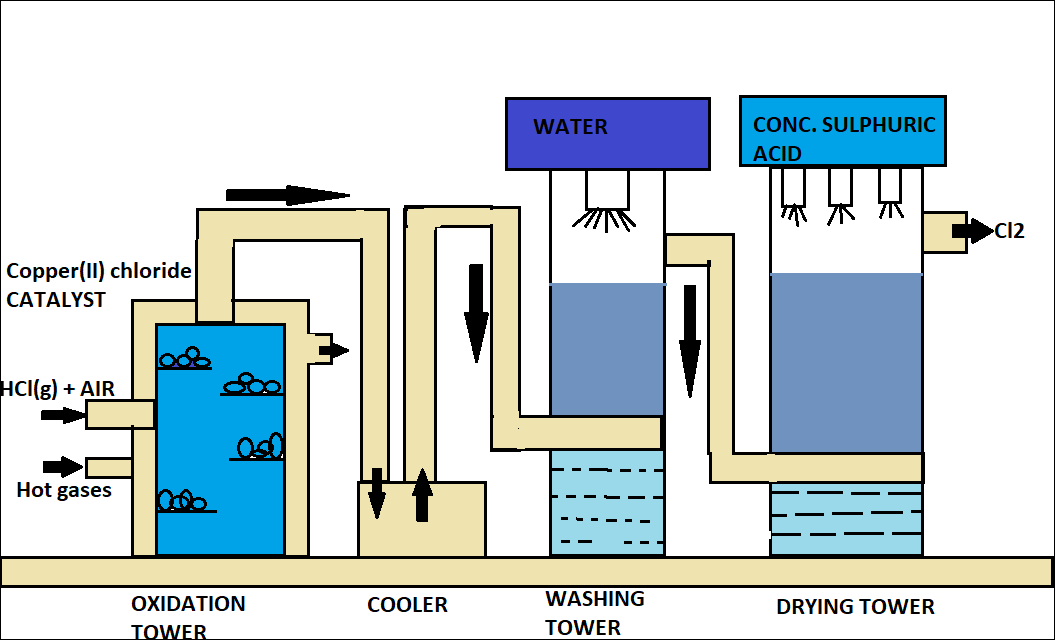
Answer
437.4k+ views
Hint:. Try to recall that chlorine is greenish yellow gas and has a strong pungent and suffocating smell odour. Also, due to its high electronegativity, chlorine is a very reactive element. Now, by using this you can easily answer the given question.
Complete step by step answer:
- It is known to you that there are a lot of methods by which chlorine gas can be prepared of which we will discuss about the deacon process.
In this process, hydrochloric acid is oxidized by atmospheric air in the presence of $CuC{l_2}$ (catalyst) at 723 K. The reaction is:
$HCl + {O_2}\xrightarrow[{Catalyst~723K}]{{CuC{l_2}}}2C{l_2} + 2{H_2}O$
- The above reaction is reversible and results in about 65% conversion. Nowadays, this method is modified by using improved catalyst $CuC{l_2}$ with didymium oxide as promoter, didymium is an old name meaning twin and it consists of two lanthanide elements praseodymium and neodymium). This process generally takes place at lower temperature.
- Now, we will see the action of ammonia with chlorine: The reaction of chlorine with ammonia depends upon the proportion of the reactants as:
If ammonia is in excess, nitrogen is formed. The reaction is as follows:
$8N{H_3} + 3C{l_2} \to 6N{H_4}Cl + {N_2}$
(excess)
- If chlorine is in excess, then nitrogen trichloride is formed. The reaction is as follows: $N{H_3} + 3C{l_2} \to NC{l_3} + HCl$ (Chlorine is in excess)
The diagram for deacon process is given below:

Note: It should be remembered to you that dry chlorine has no effect on litmus paper but in presence of moisture chlorine turns blue litmus red.
Also, you should remember that chlorine almost does not combine with hydrogen in the dark. However, in the presence of sunlight, chlorine combines with hydrogen explosively.
Complete step by step answer:
- It is known to you that there are a lot of methods by which chlorine gas can be prepared of which we will discuss about the deacon process.
In this process, hydrochloric acid is oxidized by atmospheric air in the presence of $CuC{l_2}$ (catalyst) at 723 K. The reaction is:
$HCl + {O_2}\xrightarrow[{Catalyst~723K}]{{CuC{l_2}}}2C{l_2} + 2{H_2}O$
- The above reaction is reversible and results in about 65% conversion. Nowadays, this method is modified by using improved catalyst $CuC{l_2}$ with didymium oxide as promoter, didymium is an old name meaning twin and it consists of two lanthanide elements praseodymium and neodymium). This process generally takes place at lower temperature.
- Now, we will see the action of ammonia with chlorine: The reaction of chlorine with ammonia depends upon the proportion of the reactants as:
If ammonia is in excess, nitrogen is formed. The reaction is as follows:
$8N{H_3} + 3C{l_2} \to 6N{H_4}Cl + {N_2}$
(excess)
- If chlorine is in excess, then nitrogen trichloride is formed. The reaction is as follows: $N{H_3} + 3C{l_2} \to NC{l_3} + HCl$ (Chlorine is in excess)
The diagram for deacon process is given below:

Note: It should be remembered to you that dry chlorine has no effect on litmus paper but in presence of moisture chlorine turns blue litmus red.
Also, you should remember that chlorine almost does not combine with hydrogen in the dark. However, in the presence of sunlight, chlorine combines with hydrogen explosively.
Recently Updated Pages
Who among the following was the religious guru of class 7 social science CBSE

what is the correct chronological order of the following class 10 social science CBSE

Which of the following was not the actual cause for class 10 social science CBSE

Which of the following statements is not correct A class 10 social science CBSE

Which of the following leaders was not present in the class 10 social science CBSE

Garampani Sanctuary is located at A Diphu Assam B Gangtok class 10 social science CBSE

Trending doubts
A rainbow has circular shape because A The earth is class 11 physics CBSE

Which are the Top 10 Largest Countries of the World?

Fill the blanks with the suitable prepositions 1 The class 9 english CBSE

How do you graph the function fx 4x class 9 maths CBSE

The Equation xxx + 2 is Satisfied when x is Equal to Class 10 Maths

Which is the first open university in India A Andhra class 10 physics CBSE

Difference between Prokaryotic cell and Eukaryotic class 11 biology CBSE

Give 10 examples for herbs , shrubs , climbers , creepers

Change the following sentences into negative and interrogative class 10 english CBSE




